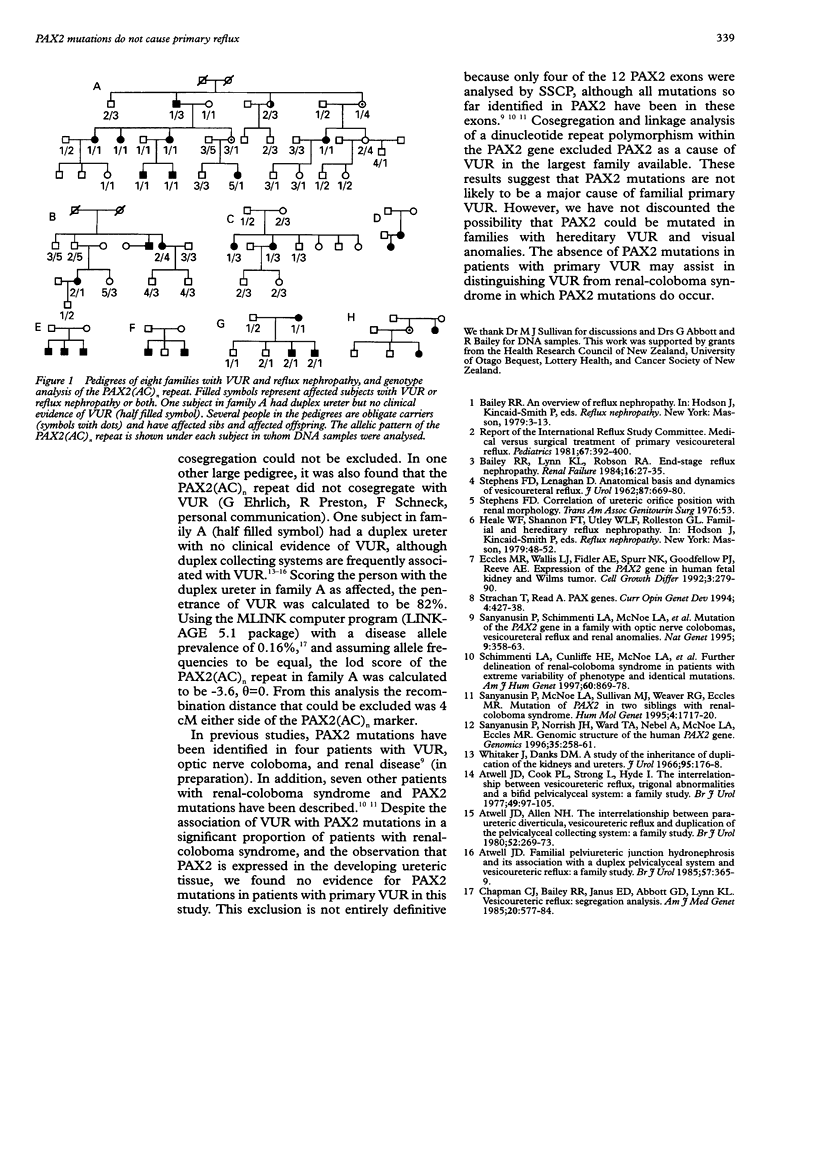Abstract
Vesicoureteric reflux (VUR) is a common childhood condition characterised by regurgitation of urine from the bladder to the kidney. It is the commonest cause of end stage renal failure in children and an important cause in adults. Primary VUR is often familial, suggesting that genetic factors play an important role in its aetiology. Recently, VUR was observed as part of a syndrome, involving optic nerve colobomas and renal anomalies, caused by mutations of the PAX2 gene. PAX2 is a member of the paired box family of genes and is expressed in the ureteric bud and differentiating nephrogenic mesenchyme of the developing kidney. PAX2 has been shown to play a critical role in the development of both the kidney and the ureter. The occurrence of VUR in one family with the PAX2 mutation, and the expression pattern of PAX2 in developing ureteric bud, strongly suggested that PAX2 could be the cause of primary familial VUR. Single strand conformational polymorphism (SSCP) analysis of 23 affected subjects in eight families with primary familial VUR showed no alterations in exons 2-5 of the PAX2 gene. In addition, a polymorphic dinucleotide repeat marker located within the PAX2 gene segregated independently of the disease trait in one large family who primarily had VUR or reflux nephropathy. These results suggest that PAX2 is not a major cause of primary familial reflux.
Full text
PDF

Selected References
These references are in PubMed. This may not be the complete list of references from this article.
- Atwell J. D., Allen N. H. The interrelationship between paraureteric diverticula, vesicoureteric reflux and duplication of the pelvicaliceal collecting system: a family study. Br J Urol. 1980 Aug;52(4):269–273. doi: 10.1111/j.1464-410x.1980.tb08915.x. [DOI] [PubMed] [Google Scholar]
- Atwell J. D., Cook P. L., Strong L., Hyde I. The interrelationship between vesico-ureteric reflux, trigonal abnormalities and a bifid pelvicalyceal collecting system: a family study. Br J Urol. 1977 Apr;49(2):97–107. doi: 10.1111/j.1464-410x.1977.tb04079.x. [DOI] [PubMed] [Google Scholar]
- Atwell J. D. Familial pelviureteric junction hydronephrosis and its association with a duplex pelvicaliceal system and vesicoureteric reflux. A family study. Br J Urol. 1985 Aug;57(4):365–369. doi: 10.1111/j.1464-410x.1985.tb06289.x. [DOI] [PubMed] [Google Scholar]
- Bailey R. R., Lynn K. L., Robson R. A. End-stage reflux nephropathy. Ren Fail. 1994;16(1):27–35. doi: 10.3109/08860229409044845. [DOI] [PubMed] [Google Scholar]
- Chapman C. J., Bailey R. R., Janus E. D., Abbott G. D., Lynn K. L. Vesicoureteric reflux: segregation analysis. Am J Med Genet. 1985 Apr;20(4):577–584. doi: 10.1002/ajmg.1320200403. [DOI] [PubMed] [Google Scholar]
- Eccles M. R., Wallis L. J., Fidler A. E., Spurr N. K., Goodfellow P. J., Reeve A. E. Expression of the PAX2 gene in human fetal kidney and Wilms' tumor. Cell Growth Differ. 1992 May;3(5):279–289. [PubMed] [Google Scholar]
- STEPHENS F. D., LENAGHAN D. The anatomical basis and dynamics of vesicoureteral reflux. J Urol. 1962 May;87:669–680. doi: 10.1016/S0022-5347(17)65025-0. [DOI] [PubMed] [Google Scholar]
- Sanyanusin P., Norrish J. H., Ward T. A., Nebel A., McNoe L. A., Eccles M. R. Genomic structure of the human PAX2 gene. Genomics. 1996 Jul 1;35(1):258–261. doi: 10.1006/geno.1996.0350. [DOI] [PubMed] [Google Scholar]
- Sanyanusin P., Schimmenti L. A., McNoe L. A., Ward T. A., Pierpont M. E., Sullivan M. J., Dobyns W. B., Eccles M. R. Mutation of the PAX2 gene in a family with optic nerve colobomas, renal anomalies and vesicoureteral reflux. Nat Genet. 1995 Apr;9(4):358–364. doi: 10.1038/ng0495-358. [DOI] [PubMed] [Google Scholar]
- Schimmenti L. A., Cunliffe H. E., McNoe L. A., Ward T. A., French M. C., Shim H. H., Zhang Y. H., Proesmans W., Leys A., Byerly K. A. Further delineation of renal-coloboma syndrome in patients with extreme variability of phenotype and identical PAX2 mutations. Am J Hum Genet. 1997 Apr;60(4):869–878. [PMC free article] [PubMed] [Google Scholar]
- Strachan T., Read A. P. PAX genes. Curr Opin Genet Dev. 1994 Jun;4(3):427–438. doi: 10.1016/0959-437x(94)90032-9. [DOI] [PubMed] [Google Scholar]
- Stuart E. T., Gruss P. PAX genes: what's new in developmental biology and cancer? Hum Mol Genet. 1995;4(Spec No):1717–1720. doi: 10.1093/hmg/4.suppl_1.1717. [DOI] [PubMed] [Google Scholar]
- Whitaker J., Danks D. M. A study of the inheritance of duplication of the kidneys and ureters. J Urol. 1966 Feb;95(2):176–178. doi: 10.1016/S0022-5347(17)63429-3. [DOI] [PubMed] [Google Scholar]


